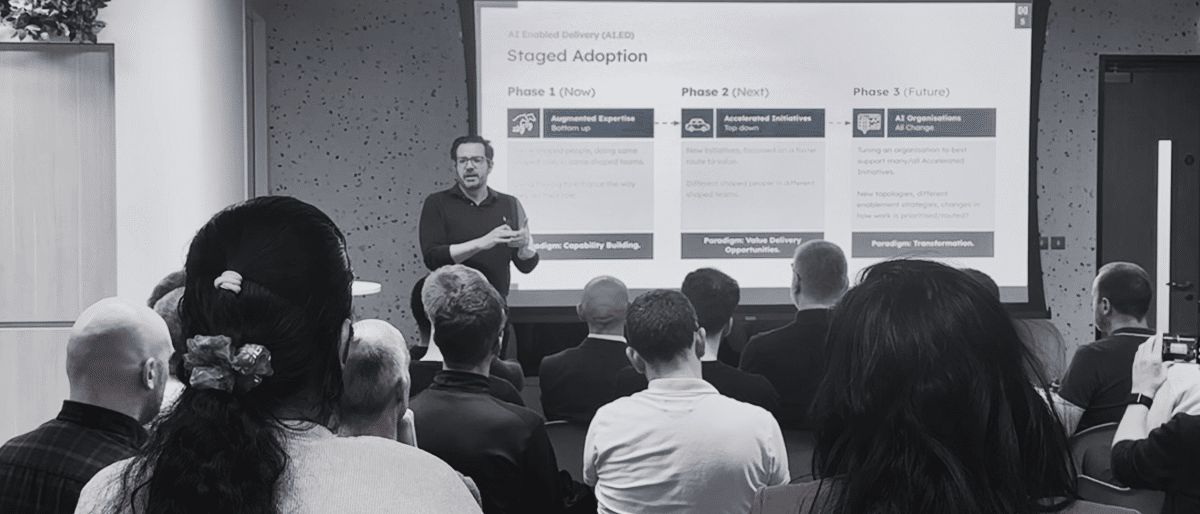Anthropic have shared a fascinating window into how Claude is being used in practice.
Among the many insights in the post, one particular statistic stood out:
Only 13% of AI usage was tied to enterprise software development, while a full 33% served startup-related work.
In our view, the analysis comes with a big asterisk — it doesn’t attempt to evaluate whether the usage of Claude is actually generating value. We don’t know whether these interactions are leading to better software, faster delivery, or more resilient systems. But just the activity levels are at least interesting in themselves: AI tooling is being integrated into the SDLC at pace, and it’s the startups leading the charge.
This raises a critical question for large organisations: Are you getting left behind in AI Delivery?
AI delivery is happening — just not (yet) in the enterprise
Startups often have a cultural and structural advantage when it comes to adopting new tools. Their development teams are smaller, governance is lighter, and experimentation is often a competitive necessity. The Anthropic research shows this agility playing out at scale: startups are running tens of thousands of interactions with Claude Code, exploring everything from debugging and refactoring to design and documentation.
By contrast, enterprises — the very organisations with the most to gain from AI at scale — are lagging behind. Some of this is understandable. Risk appetite is lower. Security and compliance reviews are more rigorous. And there’s still widespread uncertainty about how best to integrate LLMs into mature engineering workflows without creating shadow tech or bypassing trusted controls. But ultimately, this looks like the classic problem of enterprise inertia.
But as the tooling improves, and as GenAI becomes increasingly embedded in IDEs, test suites, documentation generators, and CI/CD platforms, the lag starts to look more like a liability. The cost of not acting begins to grow.
From curiosity to capability
If there’s one takeaway from the Anthropic post, it’s this: AI is already being used to understand, write, and review code — just not uniformly. What we’re seeing is a frontier of AI Delivery forming outside traditional enterprise walls.
We’ve seen this before. The early adopters of Agile, Continuous Delivery, DevOps, and Cloud all started small. But those who delayed adoption were eventually forced to play catch-up, often at high cost. We may be witnessing a similar inflection point — not a revolution, but an accumulation of advantage.
This isn’t a call to recklessness. Generative AI still has real challenges when it comes to accuracy, maintainability, and trust. But waiting for perfect safety might mean missing the practical value already being realised elsewhere.
So what should enterprises do?
- Start somewhere. Begin with pilots in low-risk areas — test automation, internal tooling, documentation. These are great proving grounds.
- Invest in literacy. Ensure your whole delivery organisation (and beyond) understand what these tools can (and can’t) do. Build comfort and competence.
- Run Exemplars. Identify specific “goldilocks” initiatives, working with people that already have full-lifecycle experience of integrating GenAI capabilities end-to-end, and demonstrate the art-of-the-possible in delivering tangible value.
The question isn’t whether AI will play a role in software delivery. It already is. The real question is: Will your organisation be a fast follower, or will you be playing catch-up five years from now?
What we’re doing at Equal Experts
At Equal Experts, we’re embracing Responsible AI Delivery. That means helping our clients navigate this shift, take advantage of the opportunity – without falling into the traps of hype, endless POCs, or major AI product & engineering failures (of which we expect to see lots this year…)
We avoid context-free claims and focus on using AI to deliver faster time to (sustainable) value, at lower cost.
Responsible. Reliable. Robust.




